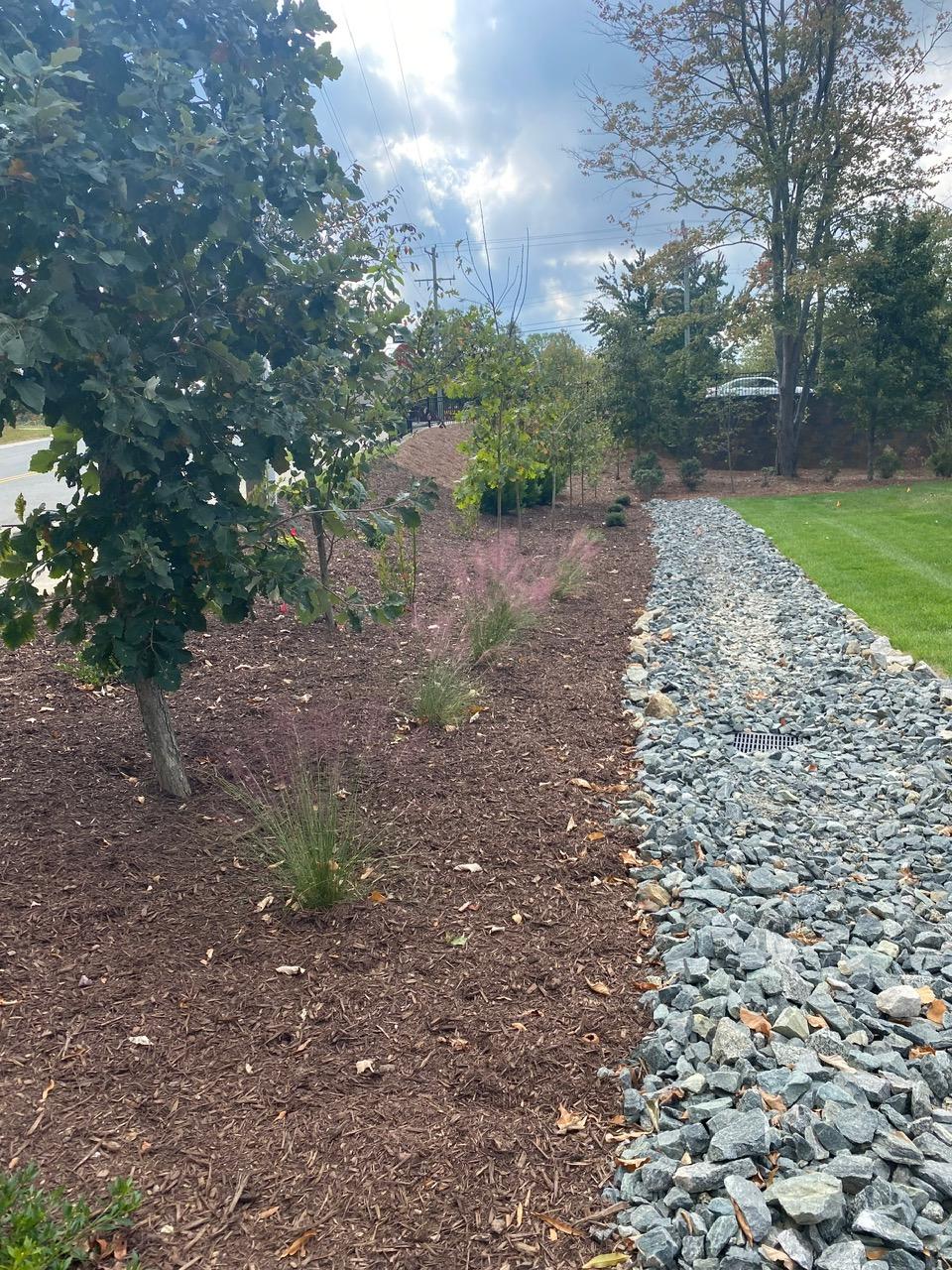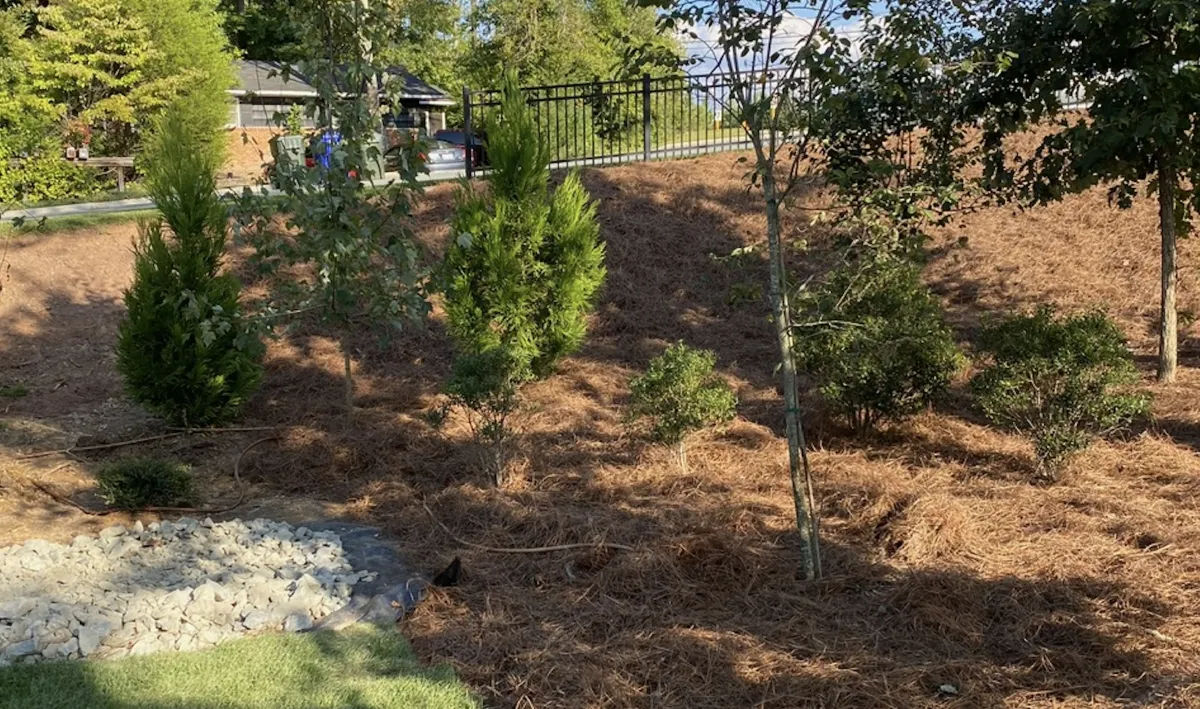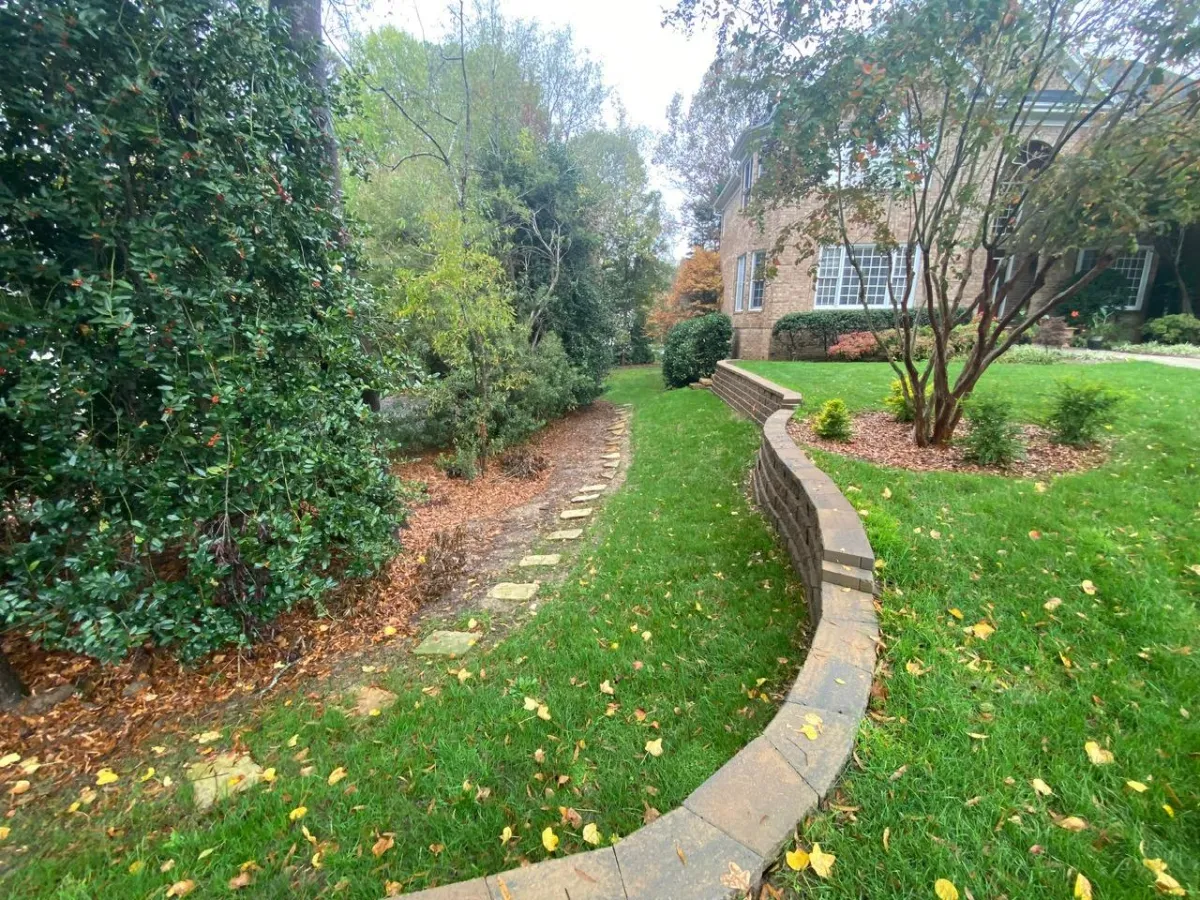Pine Straw Mulching
Contact Information and Service Requests
For more information or to request a service quote, please contact:
North Carolina: Tanner Towle, President, Owner GrowPro North Carolina
To submit a service request or receive a personalized bid, please use the “Request Bid” button above. Specify your preferred contact person if desired.
Service Overview
GrowPro offers specialized pine straw mulching services in North Carolina, utilizing locally sourced pine straw to enhance the health and appearance of your landscape. Pine straw mulching is an effective, sustainable landscaping practice that provides numerous benefits for soil and plant health.

Benefits of Pine Straw Mulching
Our pine straw mulching services provide effective benefits, including:
Moisture Retention: Pine straw helps retain soil moisture, reducing the need for frequent watering and protecting plants during dry spells.
Weed Suppression: The mulch acts as a natural barrier, significantly reducing weed growth and minimizing the need for chemical herbicides.
Soil Temperature Regulation: Pine straw insulates the soil, keeping it warmer in the winter and cooler in the summer, which helps maintain root health.
Erosion Control: The interlocking fibers of pine straw help prevent soil erosion by buffering rain impact and slowing water runoff.
Aesthetic Enhancement: Pine straw adds a clean, uniform look to the landscape, enhancing its overall appeal with a natural, rustic aesthetic.
How the Service is Delivered
Site Assessment: Our team begins with a detailed assessment of your property to determine the appropriate coverage and depth of pine straw needed.
Preparation: We prepare the landscape areas by clearing away debris and weeds, ensuring optimal conditions for mulch application.
Mulching: Pine straw is evenly spread over the designated areas, typically around trees, shrubs, and flower beds, to a uniform depth.
Maintenance: We offer follow-up services to replenish the pine straw as needed and ensure it continues to perform its protective and aesthetic functions.

Customization Options
Frequency of Replenishment: Depending on your landscape’s exposure to elements and foot traffic, we can schedule regular top-ups to keep the mulch fresh and effective.
Integrated Landscaping Solutions: Pine straw mulching can be combined with other landscaping services such as planting or irrigation adjustments for enhanced landscape health and beauty.
Pricing Information
Pricing for pine straw mulching depends on several factors:
Area Coverage: The size of the area to be mulched and the volume of pine straw required.
Accessibility: Ease of access to the areas where mulching is needed can affect the labor costs.
Frequency of Service: Regular maintenance schedules can be set up to ensure your mulch is always fresh and functional.

Safety and Compliance
Pine straw mulching is performed with consideration for environmental and property safety, ensuring that all applications are done with minimal disturbance to your daily operations.
Sustainability Practices
Local Sourcing: We source high-quality pine straw locally to reduce transportation emissions and support local businesses.
Natural Weed Control: By reducing the need for chemical treatments, pine straw mulching supports a healthier, more sustainable landscape.
How often should pine straw be replenished?
The frequency at which pine straw should be replenished in your landscape depends on several factors, including the rate of decomposition, aesthetic preferences, and the specific needs of your plants and soil. Here are some guidelines to help determine how often you should refresh your pine straw mulch:
1. Rate of Decomposition:
Pine straw tends to decompose at a moderate rate, which contributes organic matter to the soil but also means it needs to be replenished to maintain its effectiveness as mulch.
Typically, pine straw needs to be refreshed once or twice a year. It is common to add new layers in the spring to prepare for the growing season and again in the fall to protect plants during the winter.
2. Aesthetic Considerations:
The fresh color and neat appearance of new pine straw can enhance the look of your landscape significantly. As pine straw ages, it fades and settles, which might prompt a refresh to maintain curb appeal.
Properties with high visibility or those maintaining a particular aesthetic standard may choose to replenish pine straw more frequently to keep the landscape looking pristine.
3. Coverage and Thickness:
Check the thickness of the pine straw layer periodically. A depth of about 2-3 inches is ideal for effective weed suppression and moisture retention.
If the mulch has thinned out or bare spots have developed, it’s time to add more pine straw to ensure continuous coverage.
4. Seasonal Needs:
In areas with colder climates, refreshing pine straw before the winter provides an extra layer of insulation for plant roots, helping to protect them from freeze-thaw cycles.
Conversely, refreshing in the early spring can help prepare flower beds and other plant areas for the upcoming growth season, ensuring that the soil retains moisture as temperatures rise.
5. Environmental Impact:
As pine straw decomposes, it enriches the soil with organic material, but this also means it diminishes as a physical layer. Regular checks and replenishment help maintain the environmental benefits of mulching, such as soil health and moisture conservation.
By following these guidelines, you can ensure that your pine straw mulch continues to perform its crucial functions effectively, supporting your landscape’s health and beauty throughout the year.
What are the advantages of pine straw over other types of mulch?
Pine straw mulch offers several unique benefits that make it a preferred choice for many landscaping applications, particularly in areas where pine trees are abundant. Here are some key advantages of using pine straw compared to other types of mulch:
1. Natural Weed Suppression:
Pine straw mulch naturally suppresses weed growth more effectively than many other types of mulch by blocking sunlight that weeds need to sprout. This helps maintain cleaner garden and landscape areas with less need for chemical herbicides.
2. Improved Soil Health:
Acidification: Pine straw slowly acidifies the soil as it decomposes, which is beneficial for acid-loving plants such as azaleas, rhododendrons, and blueberries.Aeration and Drainage: Pine straw doesn’t compact as much as other mulches, such as bark or wood chips. This loose structure promotes better air and water circulation to the soil, enhancing root health.
3. Moisture Retention:
Pine straw helps retain soil moisture by reducing evaporation. This can be particularly advantageous during hot, dry periods, reducing the need for frequent watering and helping plants survive drought conditions.
4. Erosion Control:
The interlocking nature of pine straw needles helps anchor the mulch in place, making it an excellent choice for sloped areas where erosion control is critical. It effectively reduces soil erosion caused by wind and rain.
5. Cost-Effectiveness:
Pine straw tends to be less expensive than other mulches, especially in regions near pine forests where it is readily available. Its lightweight nature also makes it cheaper to transport and easier to spread, reducing labor costs.
6. Aesthetic Appeal:
Pine straw adds a rustic, natural look to garden beds and landscapes. Its uniform color and fine texture can enhance the visual appeal of an area more consistently than the irregular shapes and sizes of bark or wood chips.
7. Longevity:
Although it decomposes to enrich the soil, pine straw generally lasts longer than other organic mulches before needing replenishment. This makes it a durable option that doesn’t need to be replaced as frequently, offering long-term cost savings and reduced maintenance.
8. Sustainability:
Pine straw is a by-product of pine trees, which means its use as mulch does not involve the cutting down of trees, making it a sustainable choice. Collecting pine straw can also provide a cleaner forest floor, which can help reduce forest fires.
9. Easy Application:
Pine straw is lightweight and easy to handle, making it simple to transport and spread. This ease of application is beneficial for large properties or for gardeners managing their landscaping independently.
Pine straw offers a combination of aesthetic, functional, and ecological benefits that make it an attractive mulch choice for a variety of landscaping needs. Its properties especially benefit those looking for a sustainable, cost-effective solution that supports plant health and soil integrity.
Can pine straw be used in all types of gardens?
Pine straw can be a versatile and effective mulching material for many types of gardens, but its suitability depends on a few factors related to the specific garden’s needs and the type of plants being cultivated. Here are some considerations to determine if pine straw is the right choice for your garden:
1. Acidic Nature:
Suitability for Acid-Loving Plants: Pine straw naturally lowers the pH of the soil as it decomposes, making it particularly beneficial for acid-loving plants such as azaleas, rhododendrons, hydrangeas, and blueberries. If your garden features these types of plants, pine straw is an excellent mulching option.Potential Issues for Alkaline-Preferring Plants: For gardens with plants that prefer alkaline soil, such as lilacs and clematis, pine straw may not be the best choice unless soil pH is carefully monitored and adjusted.
2. Type of Garden:
Vegetable Gardens: Pine straw can be used in vegetable gardens, especially for crops that prefer slightly acidic soil conditions. It helps keep the soil moist and warm and prevents weeds, which can significantly benefit vegetable growth.
Flower Beds: For perennial and annual flower beds, pine straw works well to suppress weeds, retain soil moisture, and add aesthetic appeal.
Ornamental Gardens: Pine straw is particularly effective in ornamental gardens due to its uniform and neat appearance, which enhances the visual appeal of decorative plants.
3. Climate and Environment:
Erosion Control: Pine straw is especially advantageous in areas prone to erosion, such as sloped gardens, because its interlocking fibers help hold the mulch in place, protecting the soil from runoff.
Wind-Exposed Areas: In gardens exposed to high winds, pine straw can be more stable than lighter organic mulches, which might blow away.
4. Pest Considerations:
Natural Deterrent: Pine straw can be less attractive to certain pests, like slugs and snails, which prefer more moist and dense environments. However, it's worth noting that in some regions, pine straw may harbor termites or other insects, so local pest conditions should be considered.
5. Sustainability:
Environmental Impact: Pine straw is an environmentally friendly option as it is a by-product of pine trees and does not involve tree destruction for its production. It's also typically locally sourced in areas near pine forests, reducing the carbon footprint associated with transportation.
6. Application Ease:
Ease of Use: Pine straw is lightweight and easy to spread, making it an excellent choice for large gardens where spreading heavier mulches might be labor-intensive.
In conclusion, pine straw can be used effectively in most garden types, particularly where acidification is beneficial or neutral to the plants being cultivated. Its use should be tailored to the specific conditions and needs of the garden, considering factors like plant species, soil pH, and local climate and pests.



